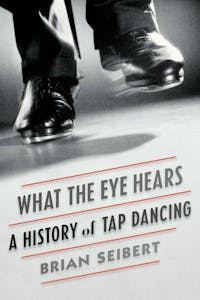What the Eye Hears
A History of Tap Dancing
 Download image
Download image
ISBN10: 0374536511
ISBN13: 9780374536510
Trade Paperback
624 Pages
$22.00
CA$30.00
A National Book Critics Circle Award Finalist
An Economist Best Book of the Year
What the Eye Hears offers an authoritative account of the great American art of tap dancing. Brian Seibert, a dance critic for The New York Times, begins by exploring tap's origins as a hybrid of the jig and clog dancing from the British Isles and dances brought from Africa by slaves. He tracks tap's transfer to the stage through blackface minstrelsy and charts its growth as a cousin to jazz in the vaudeville circuits and nightclubs of the early twentieth century. Seibert chronicles tap's spread to ubiquity on Broadway and in Hollywood, analyzes its decline after World War II, and celebrates its rediscovery and reinvention by new generations of American and international performers. In the process, the reader discovers how the history of tap dancing is central to any meaningful account of American popular culture. This is a story with a huge cast of characters, from Master Juba through Bill Robinson and Shirley Temple, Fred Astaire and Ginger Rogers, and Gene Kelly and Paul Draper to Gregory Hines and Savion Glover. Seibert traces the stylistic development of tap through individual practitioners, vividly depicting dancers both well remembered and now obscure. And he illuminates the cultural exchange between blacks and whites over centuries, the interplay of imitation and theft, as well as the moving story of African-Americans in show business, wielding enormous influence as they grapple with the pain and pride of a complicated legacy.
Reviews
Praise for What the Eye Hears
"Mr. Seibert's way of explaining tap constitutes nothing less than a social history of our country's deepest folk and pop roots . . . He rolls out a cast of thousands. . . and he layers their stories—black dancers on white on black—so deftly that a reader turning the pages gets a visceral sense of the art's constant overlap . . . "—Elizabeth Kendall, The New York Times
"There have been some valuable works [about tap dancing] but never a volume that did the real heavy lifting: critical, analytical, historical, comprehensive . . . That book has now been published."—Joan Acocella, The New Yorker
"Brian Seibert's authoritative What the Eye Hears illuminates those beginnings [of tap dance]—along with what happened afterward—as well as anyone ever will. His research is as thorough about the 1820s as about last week. Seibert . . . has smoked out every clip, sat through every silly old movie, read everything and sorted it all out for the rest of us . . . [he] does a sterling job of telling the story of where tap has been, and why it matters."—John McWhorter, The New York Times Book Review
"Seibert cares, first and foremost, about the dance as dance. He’s done a marvelous job tracking that dance, too, digging deep into primary sources to help you see, and hear, dozens of tappers from the nineteenth century to the present . . . Seibert generously invites both the famous and nearly forgotten into his pages, making a case for why each of them matters as an artist . . . This is masterful storytelling."—Megan Pugh, The New Republic
“Tap is America’s great contribution to dance, and Brian Seibert’s book gives us—at last!—a full-scale (and lively) history of its roots, its development, and its glorious achievements.”—Robert Gottlieb, dance critic for The New York Observer and editor of Reading Dance
“Brian Seibert’s What the Eye Hears not only tells you all you wanted to know about tap dancing; it tells you what you never realized you needed to know. Drawing on his massive research, Seibert follows the art through its roots, its vaudeville heyday, its forays onto Broadway and into Hollywood, its decline, its renaissance, and its dissemination beyond American shores. And he recounts all this in an easygoing style, providing vibrant descriptions of the dancing itself and illuminating commentary by those masters who could make a floor sing.”—Deborah Jowitt, author of Jerome Robbins: His Life, His Theater, His Dance and Time and the Dancing Image
"Anyone interested in dance, popular culture, and African American history will enjoy this comprehensive work.”—Carolyn Mulac, Booklist
“The word comprehensive comes to mind, but is insufficient to properly describe the depth of detail Seibert achieves . . . Fascinating, sharply written cultural analysis.”—Publishers Weekly (starred review)
Reviews from Goodreads
BOOK EXCERPTS
Read an Excerpt
1
STEALING STEPS
Whenever there’s a mixed bill of tappers, you can bet that all the dancers in the show will cram onstage at the end for the Shim Sham. Often the dancers in the audience will join in, too. Lingua...



